Discover 15 hidden attractions, cool sights, and unusual things to do in Jaipur (India). Don't miss out on these must-see attractions: Hawa Mahal, City Palace, and Jantar Mantar. Also, be sure to include Jal Mahal in your itinerary.
Below, you can find the list of the most amazing places you should visit in Jaipur (Rajasthan).
Table of Contents
Hawa Mahal
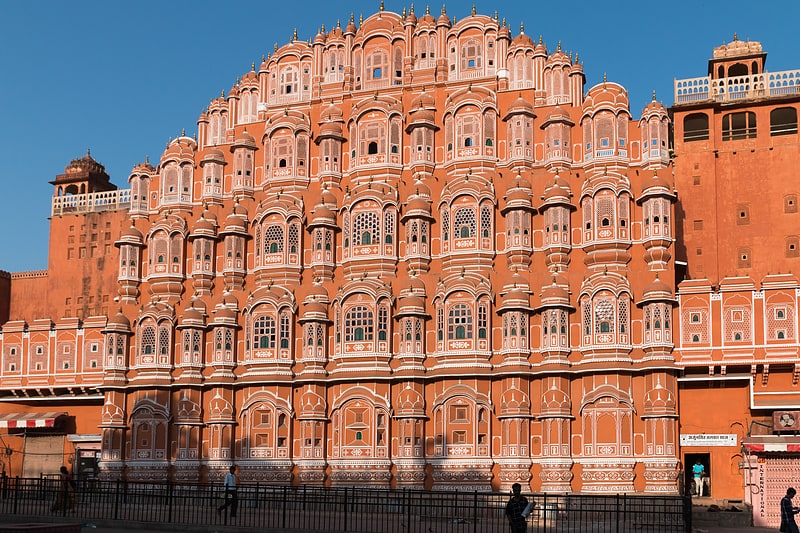
Also known as: हवामहल
Palace in Jaipur, India. The Hawa Mahal is a palace in the city of Jaipur, India. Built from red and pink sandstone, the palace sits on the edge of the City Palace, Jaipur, and extends to the Zenana, or women's chambers.
The structure was built in 1799 by the Maharaja Sawai Pratap Singh, the grandson of Maharaja Sawai Jai Singh, who was the founder of the city of Jaipur, India. He was so inspired by the unique structure the of Khetri Mahal that he built this grand and historical palace.
It was designed by Lal Chand Ustad. Its five-floor exterior is akin to a honeycomb with its 953 small windows called Jharokhas decorated with intricate latticework. The original intent of the lattice design was to allow royal ladies to observe everyday life and festivals celebrated in the street below without being seen, since they had to obey the strict rules of "purdah", which forbade them to appear in public without face coverings. This architectural feature also allowed cool air from the Venturi effect to pass through, thus making the whole area more pleasant during the high temperatures in summer. Many people see the Hawa Mahal from the street view and think it is the front of the palace, but it is the back.
In 2006, renovation works on the Mahal were undertaken, after a gap of 50 years, to give a facelift to the monument at an estimated cost of Rs 4.568 million. The corporate sector lent a hand to preserve the historical monuments of Jaipur and the Unit Trust of India has adopted Hawa Mahal to maintain it. The palace is an extended part of a huge complex. The stone-carved screens, small casements, and arched roofs are some of the features of this popular tourist spot. The monument also has delicately modelled hanging cornices.[1]
Address: Hawa Mahal Road, 302002 Jaipur
City Palace

Also known as: सिटी पैलेस, जयपुर
Lavish 1700s palace complex and museum. The City Palace, Jaipur was established at the same time as the city of Jaipur, by Maharaja Sawai Jai Singh II, who moved his court to Jaipur from Amber, in 1727. Jaipur is the present-day capital of the state of Rajasthan, and until 1949 the City Palace was the ceremonial and administrative seat of the Maharaja of Jaipur. The Palace was also the location of religious and cultural events, as well as a patron of arts, commerce, and industry. It now houses the Maharaja Sawai Man Singh II Museum, and continues to be the home of the Jaipur royal family. The palace complex has several buildings, various courtyards, galleries, restaurants, and offices of the Museum Trust.The MSMS II Museum Trust is headed by chairperson Rajamata Padmini Devi of Jaipur. Princess Diya Kumari runs the Museum Trust, as its secretary and trustee. She also manages The Palace School and Maharaja Sawai Bhawani Singh School in Jaipur. She founded and runs the Princess Diya Kumari Foundation to empower underprivileged and underemployed women of Rajasthan. She is also an entrepreneur. In 2013, she was elected as Member of the Legislative Assembly of Rajasthan from the constituency of Sawai Madhopur.[2]
Address: Johari Bazar, J.D.A. Market, Pink City, 302003 Jaipur
Jantar Mantar

Also known as: जन्तर मन्तर
Instruments for astronomical observation. The Jantar Mantar, Jaipur is a collection of 19 astronomical instruments built by the Rajput king Sawai Jai Singh II, the founder of Jaipur, Rajasthan. The monument was completed in 1734. It features the world's largest stone sundial, and is a UNESCO World Heritage site. It is near City Palace and Hawa Mahal. The instruments allow the observation of astronomical positions with the naked eye. The observatory is an example of the Ptolemaic positional astronomy which was shared by many civilizations.
The monument features instruments operating in each of the three main classical celestial coordinate systems: the horizon-zenith local system, the equatorial system, and the ecliptic system. The Kanmala Yantraprakara is one that works in two systems and allows transformation of the coordinates directly from one system to the other. It has the biggest sundial in the world.
The monument was damaged in the 19th century. Early restoration work was undertaken under the supervision of Major Arthur Garrett, a keen amateur astronomer, during his appointment as Assistant State Engineer for the Jaipur District.[3]
Address: Tripoliya Bazaar, 302020 Jaipur
Jal Mahal
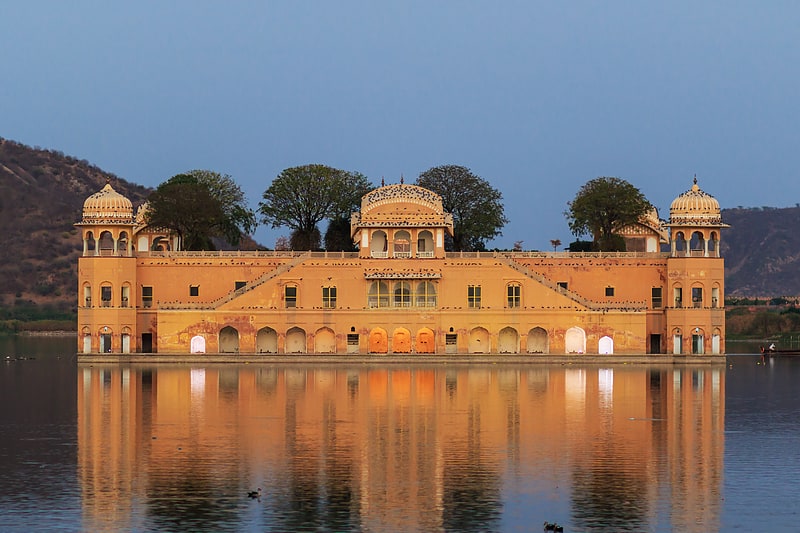
Also known as: जल महल
Historic palace in the middle of a lake. Jal Mahal is a palace in the middle of the Man Sagar Lake in Jaipur city, the capital of the state of Rajasthan, India. The palace was originally constructed in 1699; the building and the lake around it were later renovated and enlarged in the 18th century by Maharaja Jai Singh II of Amber.[4]
Albert Hall Museum
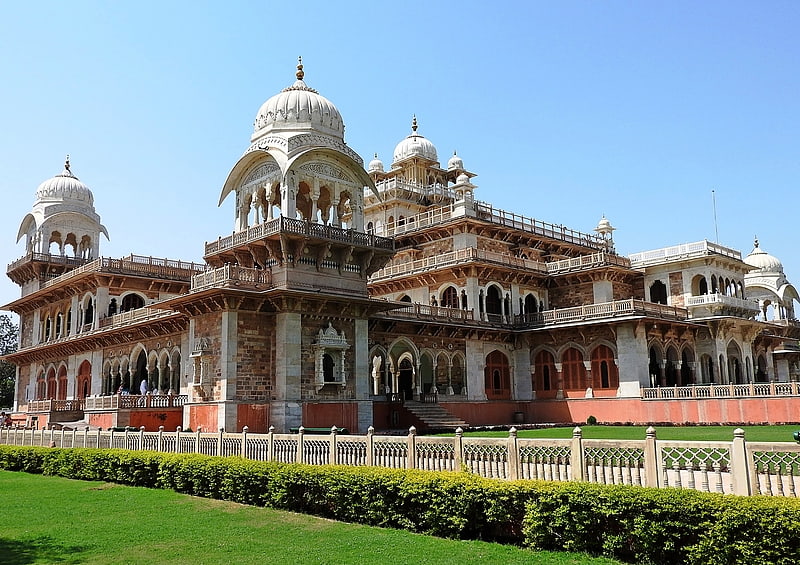
Also known as: अल्बर्ट हॉल संग्रहालय
Museum in Jaipur, India. The Albert Hall Museum in Jaipur, is the oldest museum of the state and functions as the state museum of Rajasthan, India. The building is situated in Ram Niwas garden outside the city wall opposite New gate and is a fine example of Indo-Saracenic architecture. It is also called the Government Central Museum.[5]
Address: Agrasen Hospital Marg, 302004 Jaipur
Amber Fort

Also known as: आमेर दुर्ग
Hill forts of Rajasthan. Amer Fort or Amber Fort is a fort located in Amer, Rajasthan, India. Amer is a town with an area of 4 square kilometres located 11 kilometres from Jaipur, the capital of Rajasthan. The town of Amer and the Amber Fort were originally built by Raja Man Singh and additions were, later, made by Sawai Jai Singh. Located high on a hill, it is the principal tourist attraction in Jaipur. Amer Fort is known for its artistic style elements. With its large ramparts and series of gates and cobbled paths, the fort overlooks Maota Lake, which is the main source of water for the Amer Palace.
Mughal architecture greatly influenced the architectural style of several buildings of the fort. Constructed of red sandstone and marble, the attractive, opulent palace is laid out on four levels, each with a courtyard. It consists of the Diwan-e-Aam, or "Hall of Public Audience", the Diwan-e-Khas, or "Hall of Private Audience", the Sheesh Mahal (mirror palace), or Jai Mandir, and the Sukh Niwas where a cool climate is artificially created by winds that blow over a water cascade within the palace. Hence, the Amer Fort is also popularly known as the Amer Palace. The palace was the residence of the Rajput Maharajas and their families. At the entrance to the palace near the fort's Ganesh Gate, there is a temple dedicated to Shila Devi, a goddess of the Chaitanya cult, which was given to Raja Man Singh when he defeated the Raja of Jessore, Bengal in 1604. (Jessore is now in Bangladesh). Raja Man Singh had 12 queens so he made 12 rooms, one for each Queen. Each room had a staircase connected to the King’s room but the Queens were not to go upstairs. Raja Jai Singh had only one queen so he built one room equal to three old queen’s rooms.
This palace, along with Jaigarh Fort, is located immediately above on the Cheel ka Teela (Hill of Eagles) of the same Aravalli range of hills. The palace and Jaigarh Fort are considered one complex, as the two are connected by a subterranean passage. This passage was meant as an escape route in times of war to enable the royal family members and others in the Amer Fort to shift to the more redoubtable Jaigarh Fort. Annual tourist visitation to the Amer Palace was reported by the Superintendent of the Department of Archaeology and Museums as 5000 visitors a day, with 1.4 million visitors during 2007. At the 37th session of the World Heritage Committee held in Phnom Penh, Cambodia, in 2013, Amer Fort, along with five other forts of Rajasthan, was declared a UNESCO World Heritage Site as part of the group Hill Forts of Rajasthan.[6]
Nahargarh Fort
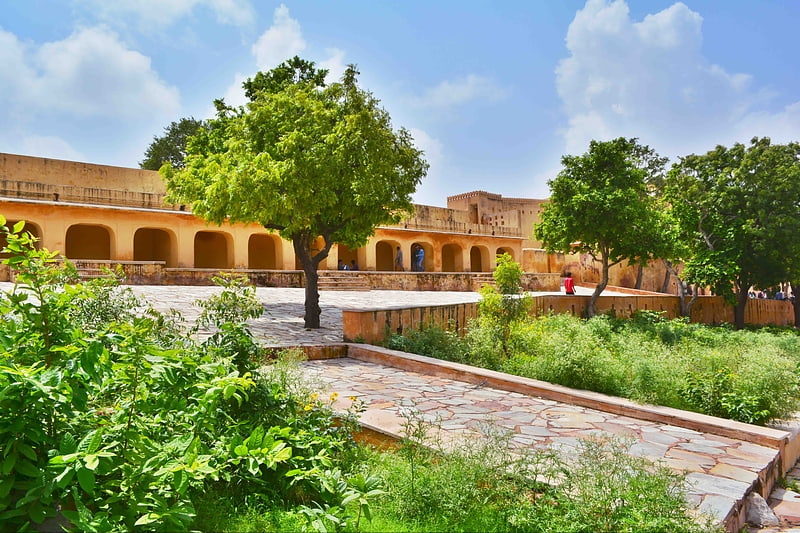
Also known as: नाहरगढ़ दुर्ग
Hilltop fort offering expansive views. Nahargarh Fort stands on the edge of the Aravalli Hills, overlooking the city of Jaipur in the Indian state of Rajasthan. Along with Amer Fort and Jaigarh Fort, Nahargarh once formed a strong defence ring for the city. The fort was originally named Sudershangarh, but it became known as Nahargarh, which means 'abode of tigers'. The popular belief is that Nahar here stands for Nahar Singh Bhomia, whose spirit haunted the place and obstructed construction of the fort. Nahar's spirit was pacified by building a temple in his memory within the fort, which thus became known by his name.[7]
Address: Nahar Garh Road, 302002 Jaipur
Ram Niwas Garden
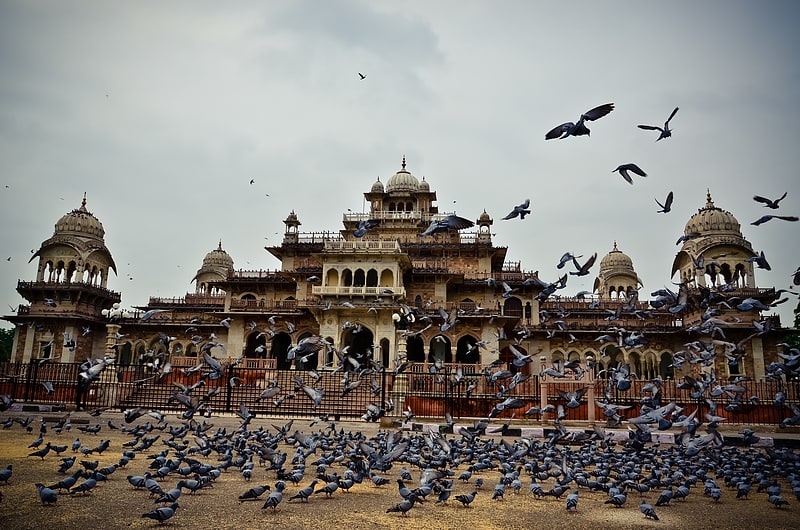
Also known as: राम निवास बाग
Park in Jaipur, India. Ram Niwas Garden is a garden situated in Jaipur city in Indian state of Rajasthan, built by Maharaja Sawai Ram Singh of Jaipur in 1868.[8]
Address: Exact city centre, Jaipur
Kalki Mandir

Kalki mahamtra “Jai Kalki Jai Jagatpate, Padma Pati Jai Ramapate”
Kalki Mandir is a Hindu temple in Jaipur, Rajasthan, India, which was built by Jai Singh II in the 18th century.One of the oldest Kalki Temple known. Kalki avtaar is the 10th incarnation of MahaVishnu ji who will end 28th Kaliyug. The temple is located in Sireh Deori Bazar opposite the palace gate. In the temple yard is a statue of a horse made of white marble. The temple contains statues of Kalki avatar and goddess Lakshmi.[9]
Birla Mandir
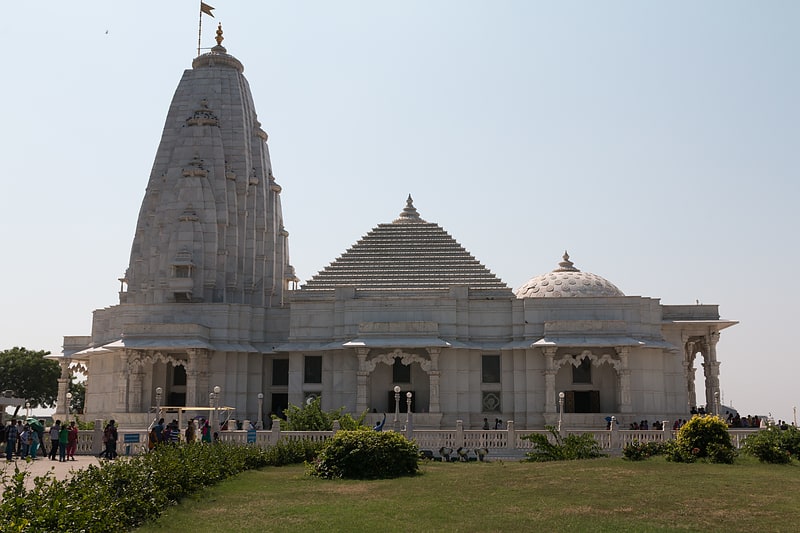
Also known as: बिड़ला मन्दिर, जयपुर
Hindu temple in Jaipur, India. Birla Mandir, Jaipur is a Hindu temple located in Jaipur, India and is one of many Birla mandirs. It was built by the B.M. Birla Foundation in 1988 and is constructed solely of white marble. It is dedicated to the Hindu Goddess Lakshmi and Lord Vishnu, whose images appear inside, along with other Hindu gods and goddesses and selections from the Gita and Upanishads. Festivals such as Diwali and Janamashtami are celebrated at the temple. The temple is open daily with visiting hours between 8:00 AM and 12:00 PM, as well as between 4:00 PM and 8:00 AM. It is located in Jaipur's Tilak Nagar neighborhood near Moti Dungari hill.[10]
Address: Jawahar Lal Nehru Marg, 302004 Jaipur
Jawahar Kala Kendra

Also known as: जवाहर कला केन्द्र
Museum in Jaipur, India. The Jawahar Kala Kendra is a multi arts centre located in the city of Jaipur, India. It was built by Government of Rajasthan with the purpose of preserving Rajasthani arts and crafts.
The centre has been made in eight blocks housing museums, one amphi theatre and the other closed auditorium, library, arts display rooms, cafeteria, small hostel and art-studio.
It also houses two permanent art galleries and three other galleries. and host its own theatre festival each year.[11]
Address: JLN Marg, 302013 Jaipur
Raj Mandir Cinema
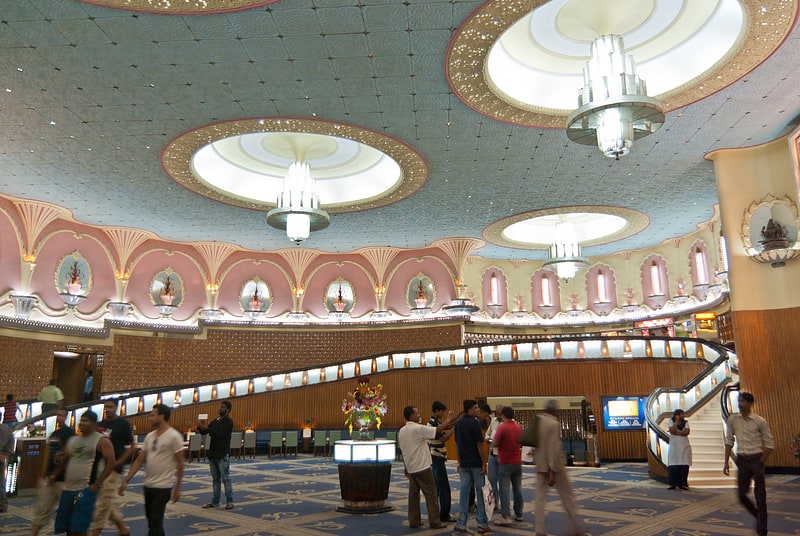
Movie theatre in Jaipur, India. Raj Mandir Cinema is a movie theatre in Jaipur in Rajasthan state in India. Situated on the Bhagwan Das Road, near M.I. Road, the meringue-shaped auditorium opened in 1976, and over the years has seen many movie premieres of Hindi films, and has become a popular symbol of Jaipur.[12]
Address: Jaipur, B-16, Panch Batti, Bhagwan Das Rd,Jaipur - 302001
Man Sagar Lake
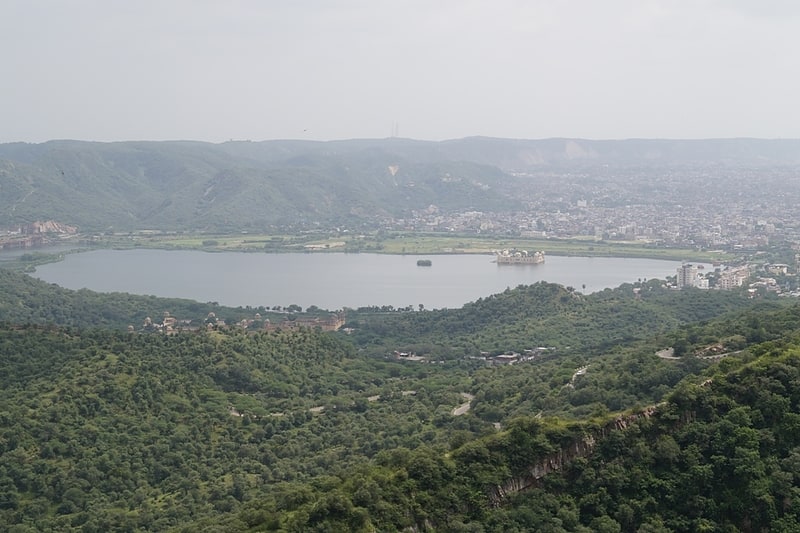
Lake in India. Man Sagar Lake is an artificial lake, situated in Jaipur, the capital of the state of Rajasthan in India. It is named after Raja Man Singh, the then ruler of Amer, who constructed it in c. 1610 by damming the Dravyavati river. The Jal Mahal is situated in the middle of the lake.[13]
Moti Dungri
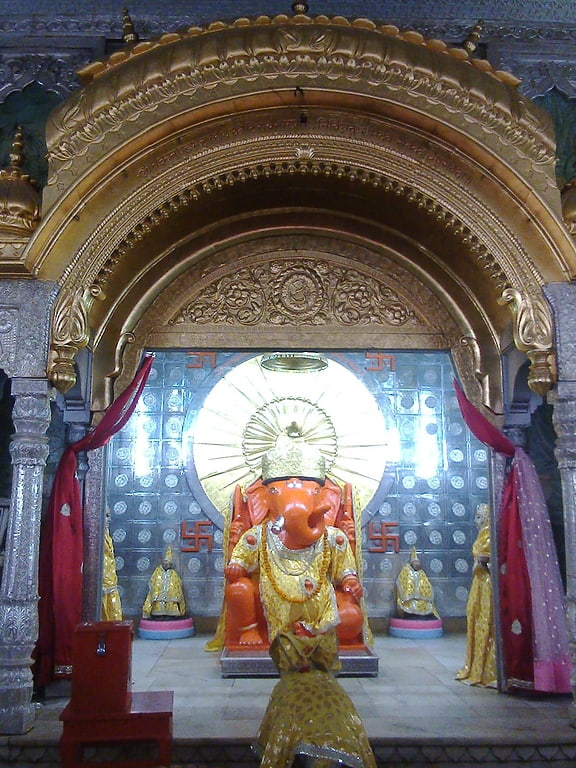
Moti Dungri is a Hindu temple complex dedicated to lord Ganesha in Jaipur, Rajasthan. It was built in 1761 under supervision of Seth Jai Ram Paliwal. The temple is a popular tourist attraction in the city.[14]
Address: Moti Doongri Road, Jaipur
Kanak Vrindavan
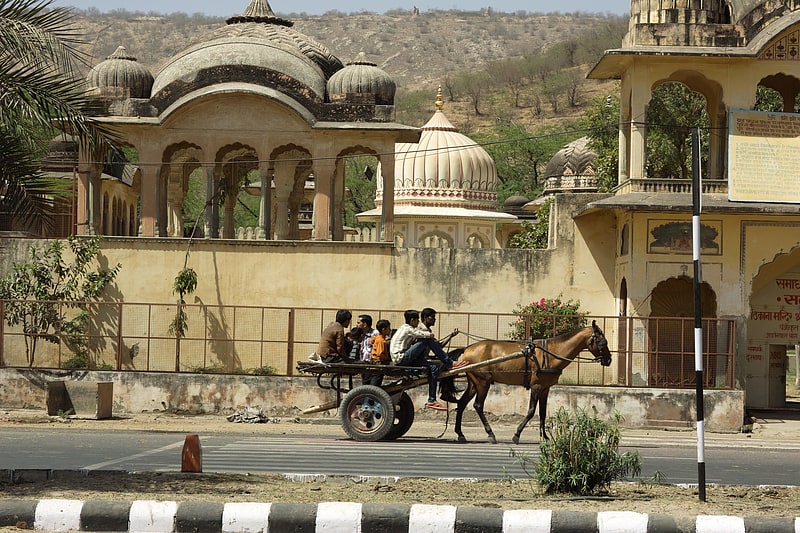
Also known as: कनक वृंदावन
Park in Jaipur, India. Kanak Vrindavan is a garden in Jaipur, the capital of Rajasthan. It is built in a valley surrounded by Aravali hills and is located on the way to the Amer Fort at the bottom of the Nahargarh hill. The place is approx 8 km north of the Jaipur city. The garden complex is having many nearby tourist attractions as the Amer fort Palace, Jaigarh fort and Nahargarh fort along with much lush greenery. The garden was coined by Kachchwaha Rajput Maharaja Sawai Jai Singh of Jaipur, approximately 275 years ago, at the time when the complex was built. It includes term 'Vrindavan' as the garden resembles the descriptions of the place, where God Sri Krishna had performed MahaRaas near Mathura, and word Kanak came from Maharaja's one of the Maharani Kanakde. This garden is compared to the valley of Vrindavan and the maharaja, consecrated an idol of Sri Krishna in a temple in the Kanak Vrindavan valley called the Shri Govind Deoji Parisar. The garden has a temple, a series of fountains and intricate marble decorations. It is managed by the Government of Rajasthan.[15]